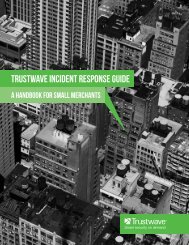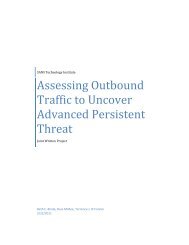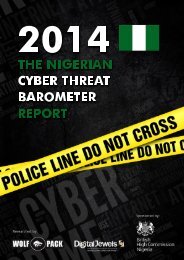Create successful ePaper yourself
Turn your PDF publications into a flip-book with our unique Google optimized e-Paper software.
Introduction<br />
Targeted attacks, aka advanced persistent threats (APTs), refer to a category of threats<br />
that aim to exfiltrate data. These comprise six components—intelligence gathering,<br />
point of entry, command and control (C&C), lateral movement, asset/data discovery,<br />
and data exfiltration, which includes a maintenance phase that allows threat actors<br />
to maintain their foothold within networks. Attackers initially gather target victims’<br />
profile information, which is then used as a delivery mechanism to gain entry into their<br />
networks. Once communication between compromised systems and C&C servers under<br />
attacker control is established, threat actors can then laterally move throughout the<br />
network and identify sensitive files to exfiltrate. In data exfiltration, an organization’s<br />
“crown jewels” are transferred to a location predefined by the attackers.<br />
This report features targeted attack cases that Trend Micro analyzed in 2014, including<br />
information on attack-related C&C infrastructure monitored. While there were<br />
limitations to our coverage, as is common in any given field, the data we obtained<br />
allowed us to understand the behaviors and nature of the activities that posed great<br />
threats to the computing public.<br />
In 2014, we saw a mix of seemingly state- and nonstate-sponsored attacks. Examples<br />
of the latter include Operation Arid Viper and Pitty Tiger. 1 Regardless of type, however,<br />
intelligence gathering and data exfiltration were attacks’ common denominator. We<br />
have seen breaches wherein people from the target organization acted as perpetrators<br />
as in Amtrak’s case. 2 While threat actors normally target commercial tools and software,<br />
they can also go after highly specific applications, as seen in attacks against a particular<br />
supervisory control and data acquisition (SCADA) system solution. 3<br />
Threat actors have refined their tactics to evade detection and maintain persistence<br />
within target networks. These techniques include abusing legitimate tools such<br />
as Windows ® PowerShell and legitimate platforms such as Dropbox for C&C<br />
communication. Targeted attack techniques have proven so effective, prompting even<br />
cybercriminals to employ them. This change has expanded cybercriminals’ victim base<br />
as seen in Predator Pain and Limitless. 4<br />
Amid the changes, one thing remains—enterprises need to adopt more effective<br />
solutions and employ better strategies to combat risks that targeted attacks pose. They<br />
need to keep up with improvements in targeted attack techniques and methodologies to<br />
mitigate and thwart attacks before data exfiltration occurs.










